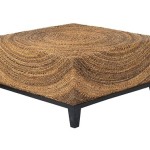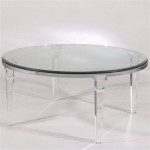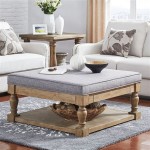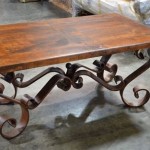How To Paint Coffee Table Rustic Wooden Legs
Achieving a rustic painted finish on coffee table legs is a popular method for enhancing the aesthetic appeal of furniture, giving it a weathered and characterful appearance. This article provides a detailed guide on how to effectively paint coffee table legs to achieve a rustic look, covering essential preparation steps, painting techniques, and finishing touches.
The rustic aesthetic emphasizes imperfections and natural textures, often drawing inspiration from aged and reclaimed materials. Applying this style to coffee table legs can transform an ordinary piece of furniture into a unique focal point. The key to success lies in understanding the underlying principles of the rustic style and applying appropriate techniques to mimic the effects of time and wear.
Before embarking on the painting process, adequate preparation is critical for ensuring a durable and visually pleasing result. This includes thoroughly cleaning the legs, sanding the surface to create a suitable texture for paint adhesion, and applying a primer to promote even coverage and longevity.
Preparing the Wooden Legs
The first step in preparing the wooden legs is to thoroughly clean them. Accumulated dust, dirt, and grease can prevent proper paint adhesion and compromise the final finish. A mild detergent solution and a clean cloth are typically adequate for removing surface contaminants. For more stubborn stains or grease, a stronger degreaser may be necessary. Ensure that the legs are completely dry before proceeding to the next step.
Sanding is an essential step for creating a surface that is receptive to paint. Use sandpaper with varying grits, starting with a coarser grit (e.g., 80-120 grit) to remove any existing finish or imperfections. Smooth out the surface with a finer grit sandpaper (e.g., 220 grit) to create a smooth base for painting. Sanding should be done in the direction of the wood grain to avoid scratching and damaging the wood. Remove all sanding dust with a tack cloth or a vacuum cleaner before moving on.
Priming is a crucial step that often gets overlooked, but it significantly contributes to the final appearance and durability of the paint job. Primer creates a consistent surface for the paint to adhere to, preventing the wood from absorbing too much paint and ensuring even color coverage. Choose a primer specifically designed for wood surfaces. Apply the primer in thin, even coats, following the manufacturer's instructions. Allow the primer to dry completely before applying the paint. Depending on the type of wood and the desired finish, multiple coats of primer may be necessary.
If there are any imperfections in the wood, such as holes or cracks, wood filler can be used to repair them. Allow the wood filler to dry completely before sanding it smooth. Ensure the wood filler is sanded flush with the surrounding wood surface for a seamless repair. Clean the area thoroughly after sanding before applying primer or paint.
Applying the Paint for a Rustic Effect
Selecting the right type of paint is crucial for achieving the desired rustic look. Chalk paint and milk paint are popular choices for creating a distressed finish, as they adhere well to wood surfaces and can be easily sanded or chipped to reveal the underlying layers. Alternatively, acrylic paints can also be used, especially when combined with distressing techniques. Consider the color scheme and the overall aesthetic you are aiming for when choosing the paint color.
Creating a layered paint effect is a fundamental technique for achieving a rustic appearance. This involves applying multiple coats of different paint colors, allowing some of the underlying layers to show through. Start by applying a base coat of a darker color, such as dark brown or black. Once the base coat is dry, apply a top coat of a lighter color, such as cream or white. This contrast between the layers will create visual interest and enhance the rustic effect.
Distressing techniques are pivotal in creating the aged and weathered appearance characteristic of rustic furniture. Sanding is one of the most common distressing methods. Use sandpaper to remove paint from edges, corners, and surfaces that would naturally wear over time. Focus on areas that would typically experience the most use and abrasion. Another distressing technique is dry brushing, which involves applying a small amount of paint to a brush and then wiping off most of the paint before applying it to the surface. This creates a subtle, textured effect. Other techniques include using a hammer or chain to create dents and scratches, and applying a stain or glaze to highlight the texture and add depth.
The method of paint application can greatly influence the final texture and appearance of the legs. Brushes tend to leave visible brushstrokes, which can contribute to the rustic aesthetic. Sponges can create a stippled effect, adding another layer of texture. Consider experimenting with different application methods to achieve the desired look. Avoid applying the paint too thickly, as this can obscure the texture of the wood and make it difficult to distress the paint effectively.
After applying the desired paint layers and distressing techniques, allow the paint to dry completely. This will ensure that the finish is durable and resistant to chipping or peeling. The drying time will vary depending on the type of paint used and the ambient temperature and humidity. Refer to the manufacturer's instructions for specific drying times.
Sealing and Protecting the Finish
Once the paint job is complete and dry, applying a protective sealant is essential for preserving the finish and protecting it from wear and tear. Sealants can prevent the paint from chipping or fading over time and make the legs easier to clean. Polyurethane, varnish, and wax are common choices for sealing painted wood surfaces. Choose a sealant that is compatible with the type of paint used.
Applying the sealant in thin, even coats is crucial for achieving a smooth and consistent finish. Avoid applying too much sealant at once, as this can cause drips and runs. Use a brush or a cloth to apply the sealant, following the manufacturer's instructions. Allow each coat of sealant to dry completely before applying the next coat. Lightly sand the surface between coats to remove any imperfections and create a smoother finish.
Wax is a popular choice for sealing rustic painted finishes, as it enhances the texture and provides a soft, matte sheen. Apply the wax with a clean cloth, working it into the surface of the wood. Allow the wax to dry for the recommended time, and then buff it with a clean cloth to create a smooth and polished finish. Wax provides a protective layer while maintaining the rustic look and feel.
Depending on the desired level of protection and durability, multiple coats of sealant may be necessary. For high-traffic areas or furniture that will be exposed to moisture, consider applying two or three coats of sealant. Allow each coat to dry completely before applying the next coat. Lightly sand the surface between coats to ensure a smooth and even finish.
After applying the final coat of sealant, allow it to dry completely before using the coffee table. This will ensure that the finish is fully cured and resistant to damage. Avoid placing heavy objects on the coffee table until the sealant is completely dry. Clean the coffee table legs with a soft, damp cloth to remove any dust or dirt. Avoid using harsh chemicals or abrasive cleaners, as these can damage the finish.
Maintaining the rustic painted finish requires regular cleaning and occasional touch-ups. Dust the legs regularly with a soft cloth to prevent the buildup of dirt and grime. If the finish becomes scratched or chipped, touch up the damaged areas with paint and sealant. Follow the same steps as the initial painting process to ensure a seamless repair. With proper care and maintenance, the rustic painted finish on the coffee table legs will retain its beauty and character for years to come.
Understanding the materials used and their properties is crucial for achieving successful results. Different types of wood will react differently to paint and sealant, so it's important to choose products that are compatible with the specific type of wood used for the coffee table legs. Hardwoods, such as oak and maple, are more durable and resistant to wear and tear than softwoods, such as pine and cedar. Consider the wood type when selecting paint and sealant.
Proper drying times are critical for ensuring a durable and long-lasting finish. Allow the paint, primer, and sealant to dry completely before proceeding to the next step. Rushing the drying process can lead to incomplete curing and a compromised finish. Factors such as temperature, humidity, and ventilation can affect the drying time. Refer to the manufacturer's instructions for specific drying times and recommendations.
Experimentation is key to achieving the desired rustic look. Don't be afraid to try different painting techniques, distressing methods, and sealant options. Practice on scrap wood before applying the techniques to the coffee table legs. This will allow you to refine your skills and develop a personalized approach to achieving the perfect rustic finish.

How To Refinish A Rustic Wood Coffee Table With Beautiful Results

How To Paint Table Legs The Fast And Easy Way

How To Paint A Weathered Wood Finish On Furniture

Rustic Coffee Table Makeover Life On Kaydeross Creek

Coffee Table Makeover Stained The Top And Painted Legs With A Homemade Chalk Paint Distressed Sealed Dark Wax

I Have A Fune Pine Coffee Table Makeover Farmhouse Style To Share With You New Fusion Mineral Paint Color Plus Simple Wood Aging Technique Come See How

How To Refinish A Rustic Wood Coffee Table With Beautiful Results

Coffee Table Makeover Man Cave Furniture With Rust Paint Do Dodson Designs

How To Refinish A Rustic Wood Coffee Table With Beautiful Results

Chalk Paint Coffee Table Makeover Step By Diy Guide Bricks N Blooms With Stacy Ling
Related Posts







